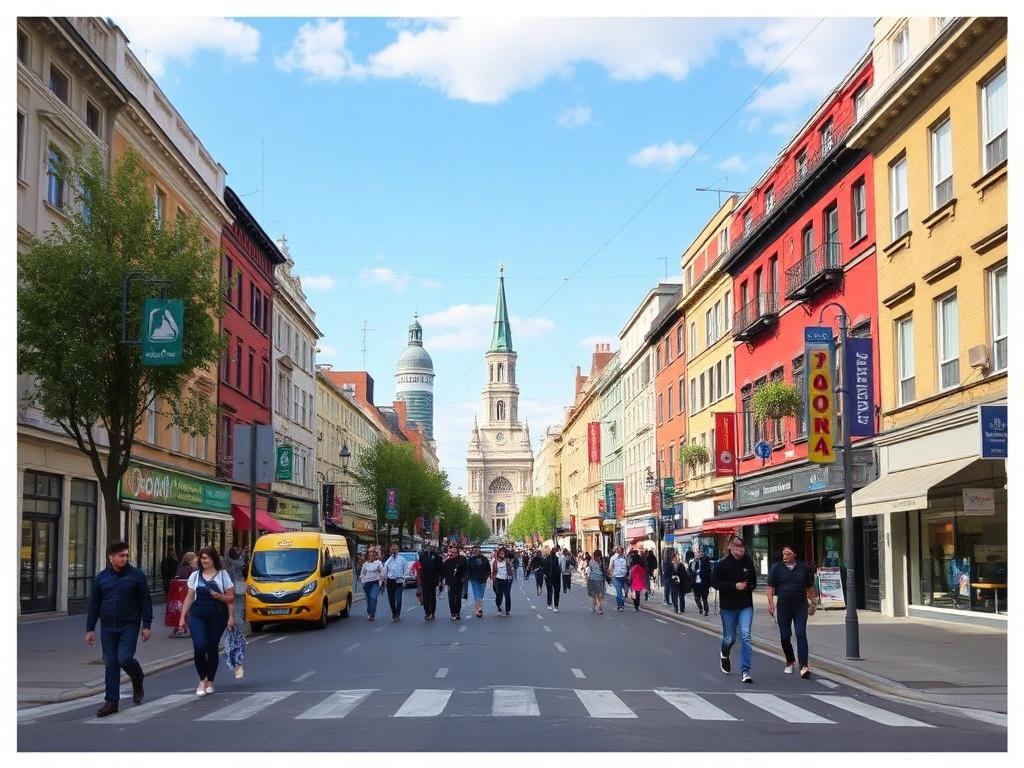
Exploring the Most Walkable Cities Worldwide: Where Every Step Counts
Walking through a city is often one of the most immersive ways to experience its culture, architecture, and everyday life. Whether you’re a local or a tourist, the ability to stroll comfortably and safely across urban spaces can transform your interaction with a city. But what exactly makes a city walkable? And which cities around the world stand out as the best places to explore on foot? In this article, we will delve deeply into the most walkable cities worldwide, highlighting their unique characteristics, features, and what makes walking there such a joyful experience.
Walkability isn’t just about having sidewalks; it’s a blend of urban design, safety, accessibility, and culture. The most walkable cities typically boast compact layouts, mixed-use development, efficient public transit, pedestrian-friendly infrastructure, and vibrant street life. As we go through this list, you will see how different cities across various continents have embraced walkability in unique ways.
What Defines Walkability in a City?
Before we dive into the list of the most walkable cities worldwide, it’s essential to understand what walkability truly means. Walkability is a measure of how friendly an area is to walking. It directly impacts the quality of life, environmental sustainability, and urban health.
Several factors contribute to walkability, including:
- Connectivity: How well the streets link with one another and provide direct routes.
- Density: The presence of destinations like shops, cafes, workplaces, and parks within walking distance.
- Safety and comfort: Well-maintained sidewalks, pedestrian crossings, lighting, and traffic calming measures.
- Aesthetics: Pleasant streetscapes, greenery, benches, and public art that make walking enjoyable.
- Access to public transportation: Convenient transit options help reduce car dependency.
- Traffic and pollution levels: Lower vehicle traffic and clean air improve the walking experience.
Cities that rank highly in walkability manage to harmonize these elements, turning everyday walks into an experience in itself.
Top Most Walkable Cities Worldwide
Here’s a curated list of some of the best walkable cities around the world that have mastered the art of urban strolling.
1. Paris, France
Paris is often cited as one of the most walkable cities worldwide. Narrow, tree-lined avenues, a compact city center, and a culture that embraces outdoor cafes and pedestrian spaces all contribute to Paris’s allure. In addition, the city’s extensive and accessible public transit system makes it easy to combine walking with metro or bus rides. Strolling along the Seine, wandering through the Marais district, or exploring the boutique-lined streets of Saint-Germain-des-Prés can all be done comfortably on foot.
2. Kyoto, Japan
Kyoto offers a walkable blend of tradition and modernity. The city’s ancient temples, beautiful gardens, and historic neighborhoods are connected by pedestrian-friendly streets. While Kyoto has modern amenities, it retains a calm atmosphere that invites slow exploration. Its efficient public transport and compact design further support walkability, making it a prime destination for those who appreciate the art of walking.
3. Melbourne, Australia
Known for its vibrant arts scene and café culture, Melbourne is also one of the most walkable cities worldwide. The central business district is a grid of accessible streets, with wide sidewalks and shaded laneways that reveal hidden bars, shops, and street art. Melbourne’s public parks and the Yarra River walking paths offer beautiful routes that cater to both casual strolls and more purposeful walks.
4. Copenhagen, Denmark
Copenhagen is renowned for its pedestrian and cyclist-friendly infrastructure. The city has reimagined its urban spaces to prioritize people over cars, transforming many areas into pedestrian zones full of shops, cafes, and cultural venues. With extensive green spaces, scenic waterfronts, and safety-focused crossings, the Danish capital meets all the criteria of a walkable city.
5. Vancouver, Canada
Vancouver’s natural beauty combined with its urban planning makes it a walkable and livable city. The city’s downtown core is pedestrian-friendly, with clearly marked sidewalks and easy access to parks like Stanley Park. Vancouver’s integration of nature and urban life encourages walking as a primary mode of getting around.
6. Amsterdam, Netherlands
Amsterdam’s compact size, flat terrain, and extensive network of canals make it perfect for walking. Though famous for its biking culture, Amsterdam’s pedestrian zones are vibrant and safe, with markets, historic sites, and cafes all a short walk apart. The city’s careful urban design reduces traffic pressures and promotes walkability.
7. New York City, USA
Despite its size, New York City offers some of the most walkable neighborhoods in the world, including Manhattan, Greenwich Village, and Brooklyn. The city’s dense mix of workplaces, cultural institutions, restaurants, and shops allows people to accomplish many daily tasks on foot. Well-marked crosswalks, wide sidewalks, and pedestrian plazas have elevated the walking experience.
Comparing Key Walkability Features of the Most Walkable Cities Worldwide
To better understand what makes these cities special, let’s compare some of their key walkability features in the table below:
| City | Public Transit Access | Pedestrian Zones | Green Spaces | Traffic Safety | Scenic Walking Routes |
|---|---|---|---|---|---|
| Paris | Excellent | Yes | Moderate | High | River Seine, Historic Districts |
| Kyoto | Good | Limited | High | High | Temples, Gardens |
| Melbourne | Good | Yes | High | High | Lanes, River Paths |
| Copenhagen | Excellent | Yes | High | Very High | Waterfronts, Parks |
| Vancouver | Good | Limited | Very High | High | Stanley Park, Seawall |
| Amsterdam | Excellent | Yes | Moderate | High | Canals, Historical Streets |
| New York City | Excellent | Yes | Moderate | Moderate | Central Park, Urban Streets |
Benefits of Living or Visiting Walkable Cities
Choosing to live in or visit walkable cities worldwide goes beyond convenience. It directly impacts health, social life, and environmental sustainability. Let’s look at some benefits:
- Health Advantages: Walking daily helps improve cardiovascular health, reduces stress, and promotes better mental wellbeing.
- Environmental Impact: Walkable cities reduce dependence on cars, lowering carbon emissions, air pollution, and urban noise.
- Economic Benefits: Vigorous foot traffic supports local businesses: cafes, shops, and markets thrive with pedestrian access.
- Social Connectivity: Walkable neighborhoods encourage interactions among residents, fostering a sense of community.
- Accessibility: People of all ages and abilities can navigate the city more comfortably and safely on foot.
As awareness of these benefits grows, more cities around the world are investing in better walkability, knowing it ultimately raises the quality of urban life.
Challenges in Developing Walkable Cities
Walkability, while highly desirable, comes with challenges. Many urban areas struggle to balance the needs of pedestrians, cyclists, and vehicles. Some obstacles include:
- Urban Sprawl: Cities that have grown horizontally over decades tend to have long distances between destinations, discouraging walking.
- Car Dominance: Heavy traffic and lack of pedestrian-friendly infrastructure make walking difficult and unsafe.
- Climate: Extreme heat, cold, or rain can deter people from walking unless cities plan for covered walkways and shaded areas.
- Economic Disparities: Some walkable areas are expensive to live in, pricing out lower-income residents and reducing diversity.
- Infrastructure Costs: Building sidewalks, pedestrian crossings, and public spaces involves significant investment and political will.
Despite these challenges, examples from the most walkable cities worldwide show that thoughtful urban planning and community engagement can overcome these hurdles.
How to Experience a City as a Walker: Tips for Enjoying Walkable Cities Worldwide
If you’re planning to visit or live in any of these walkable cities worldwide, here are some tips to make your experience even more rewarding:
- Wear Comfortable Shoes: Treat your feet well! Walking long distances requires proper footwear.
- Use Maps or Apps: Digital tools like pedestrian maps and city guides help locate the best walking routes and attractions.
- Explore Beyond Main Streets: Sometimes, the most charming streets are those off the beaten path.
- Visit Parks and Public Spaces: These are perfect places to rest, people-watch, or enjoy natural scenery.
- Time Your Walks Well: Early mornings or late afternoons often have the best light, fewer crowds, and cooler temperatures.
- Respect Local Customs: Every city has its own pedestrian etiquette —observe signals, give way when necessary, and stay alert.
By embracing these habits, walking becomes not just a mode of transport but a way to connect deeply with the city’s rhythm.
The Future of Walkability: Trends and Innovations
As urban areas expand and environmental concerns escalate, the idea of walkable cities worldwide is gaining momentum. Smart cities are integrating technology to enhance pedestrian experiences — from real-time data on crowded sidewalks to responsive street lighting and automated crosswalks that improve safety. Additionally, new urban designs favor the “15-minute city” concept, where all essential services are accessible within a 15-minute walk or bike ride.
Green infrastructure, such as permeable pavements and urban gardens, is being incorporated to make city walks more pleasant and environmentally sustainable. Cities are also expanding pedestrian zones, converting car-centric streets into lively public spaces where people can gather, shop, and socialize without worry.
Summary Table: Highlights of the Most Walkable Cities Worldwide
| City | Walking Experience | Unique Feature | Recommended Neighborhood to Walk |
|---|---|---|---|
| Paris | Charming, historic streets with cafés | Seine riverwalk and iconic landmarks | Le Marais |
| Kyoto | Serene, cultural immersion with gardens and temples | Traditional streets and tea houses | Gion District |
| Melbourne | Vibrant laneways filled with art and coffee culture | Street art and café-lined alleys | Central Business District (CBD) |
| Copenhagen | Safe, clean, and cyclist-friendly urban space | Extensive pedestrian zones and waterfronts | Strøget |
| Vancouver | Nature meets city with scenic park walks | Stanley Park Seawall | Downtown Waterfront |
| Amsterdam | Historic canals and eclectic neighborhoods | Compact layout with vibrant cultural spots | Jordaan |
| New York City | Diverse neighborhoods with iconic urban landmarks | Big city energy with green spaces | Greenwich Village |
Conclusion
The world offers many incredible places to walk, each city presenting a unique tapestry of culture, urban design, and lifestyle that you can uncover step by step. The most walkable cities worldwide combine thoughtful infrastructure, safety, accessibility, and charm to encourage residents and visitors alike to choose their feet over wheels. Whether it’s the romantic streets of Paris, the tranquil temples of Kyoto, or the bustling urban fabric of New York City, walking through these cities isn’t just about getting from one place to another — it’s about experiencing the heart and soul of the city in a personal and profound way. As urban planners continue to prioritize walkability and pedestrian-friendly spaces gain prominence, the future looks bright for cities where every step truly counts. So lace up your shoes, and get ready to explore the world’s amazing walkable cities — one unforgettable journey at a time.




